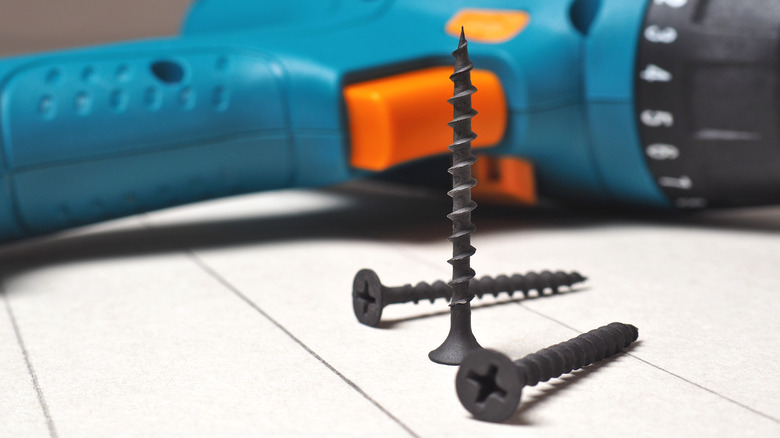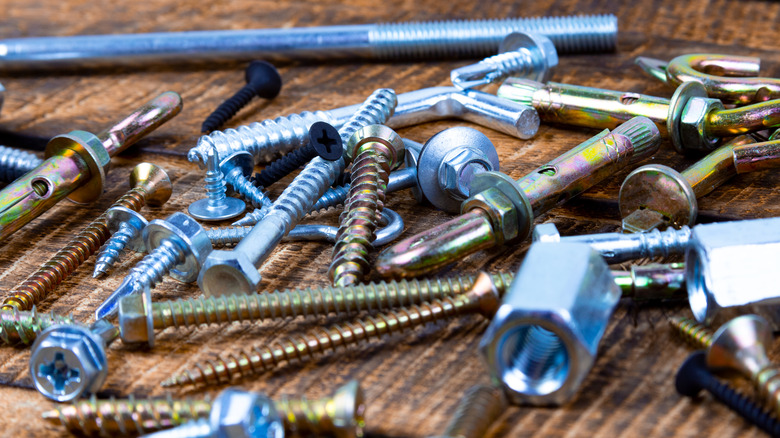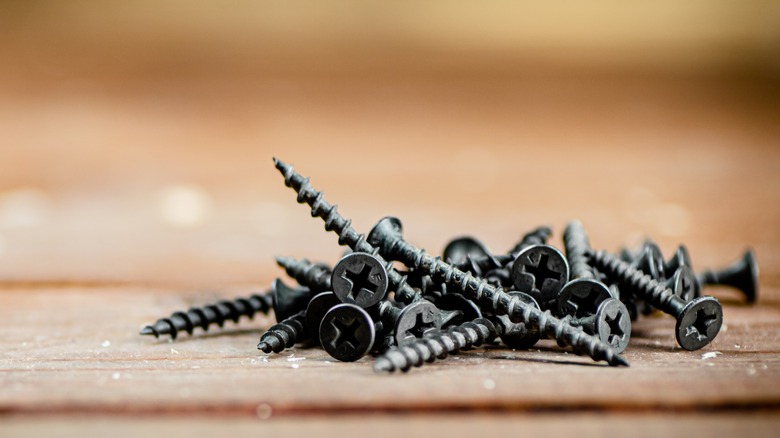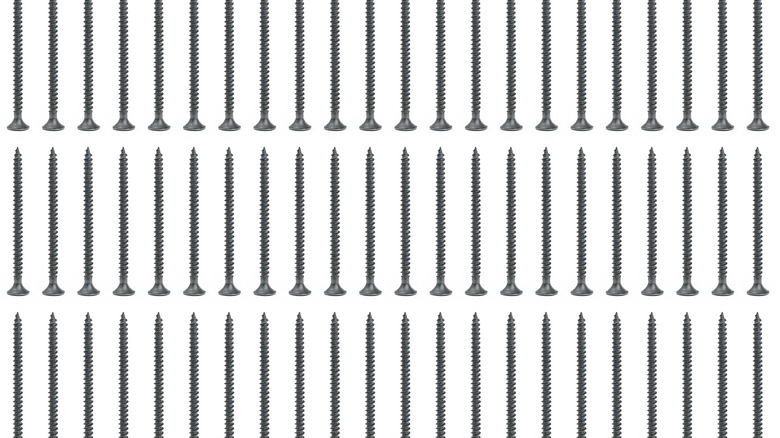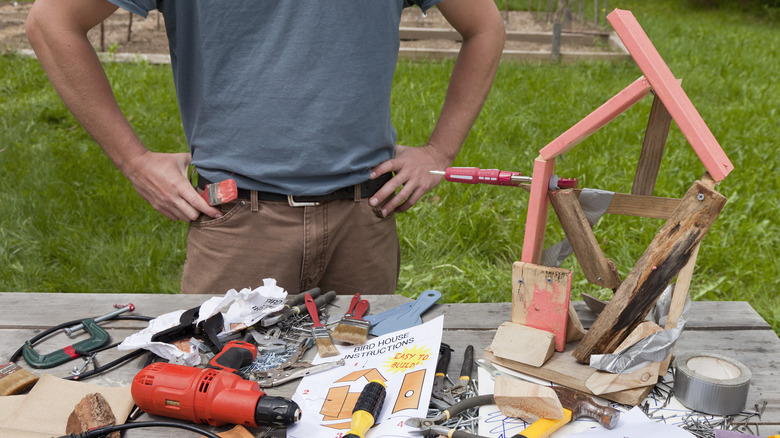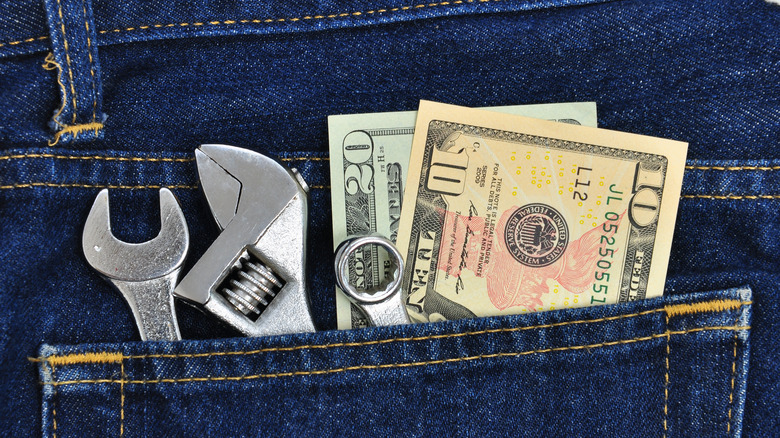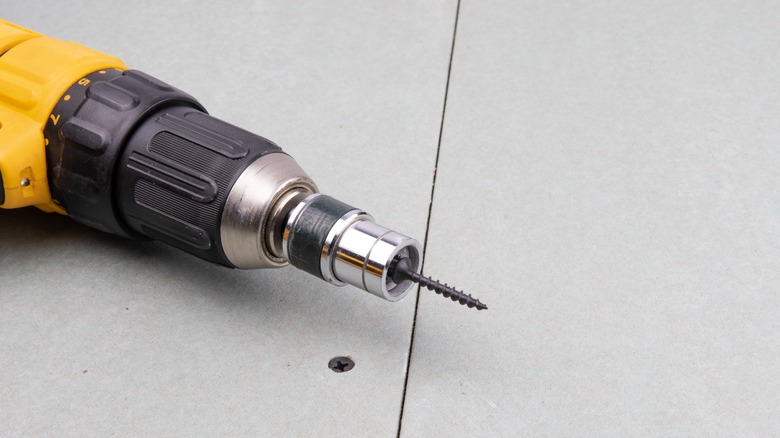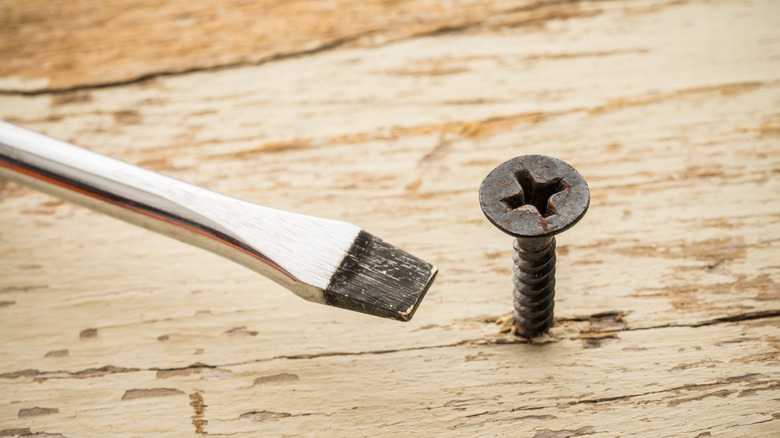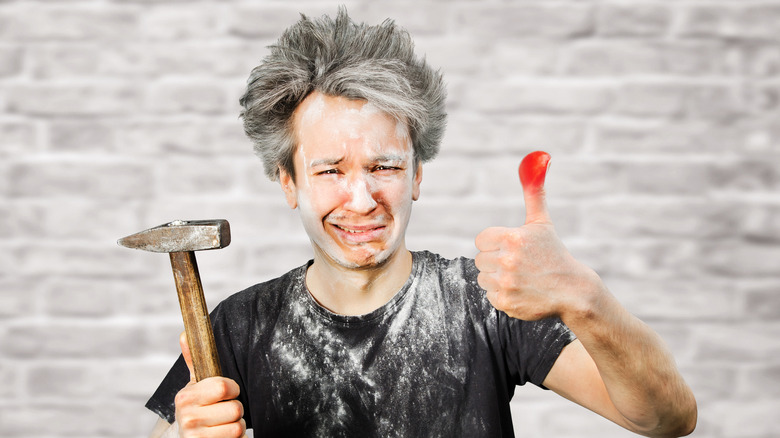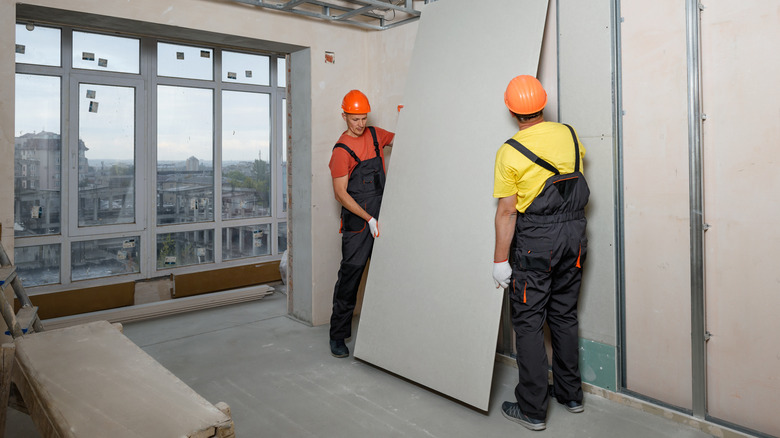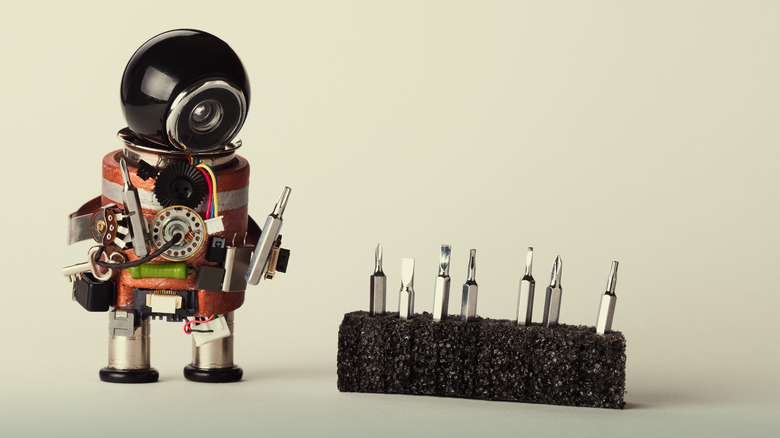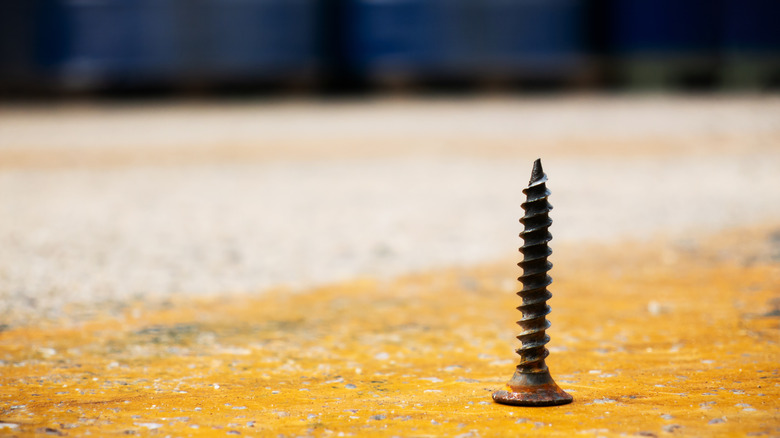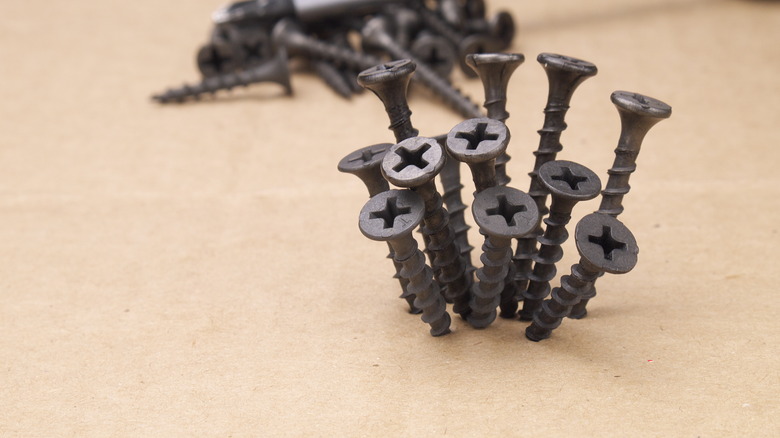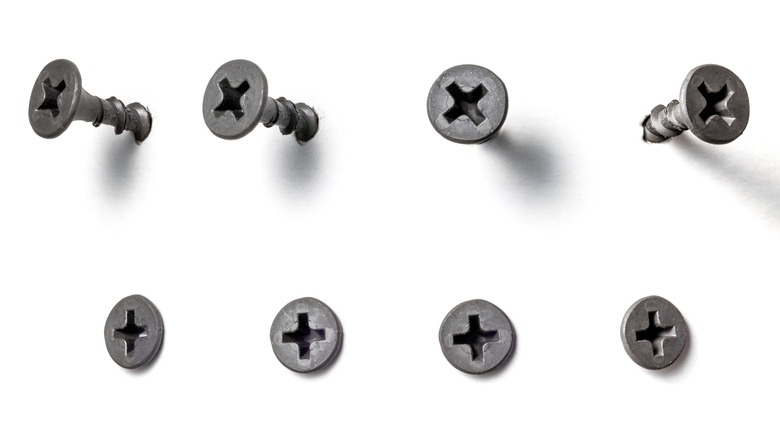What To Know Before You Buy Drywall Screws
We may receive a commission on purchases made from links.
So, you are building a little sweat equity in your home by installing drywall yourself. How complicated can it be? You already know the stuff is also called sheetrock and that something called "mudding" happens later ... you'll get to that. For now, you need some drywall and screws. What could be simpler? Like many aspects of construction, the topic of drywall screws is full of obscure details that can seem downright mysterious to the casual DIYer. Some of the information feels like secret knowledge only spoken of during midnight meetings at the masonic hall. For example, what on earth is a self-feeding collated drywall screw gun? Some nightmarish ear-piercing device? What about drywall anchors?
Never fear! There are popularizers of everything, especially on YouTube. Steve Ramsey of the fantastic Woodworking for Mere Mortals demystifies every aspect of making things (like drywall) stick to wood. However, the topic remains complicated. Wildly different screws often feature the same label, and sometimes the explanations of features contradict each other. Let's get to the bottom of it all.
What makes a drywall screw?
The average drywall screw features a few specific characteristics. In discussing the typical screw, we're disregarding some oddities that probably don't apply to the DIYer. For example, if you need to know what a drywall screw for paper-backed stucco reinforcement looks like, you can tackle that later.
According to All Points Fasteners, most drywall screws feature bugle heads, a shape unique among screws. This design allows the screw to be driven flush with the surface without pre-drilling a countersunk hole and without tearing the paper sheet that covers the drywall. Drywall screws made for wood framing usually have deeper threads than other screw types, which improves their holding power and stability (via HowStuffWorks). Screws designed to attach drywall to wood are sometimes called W-type and generally have coarser threads than S-type screws made for hanging drywall on a metal framing. Most are driven with a screw gun or drill fitted with a #2 Phillips size screw bits that controls the depth of the screw (via Drywall Questions). These are the broad strokes, but many options are available for various applications and preferences.
Which screw length to use
Drywall screws come in a few different lengths, and you can determine which to use based on the thickness and placement of the drywall you're hanging. Most drywall is ½-inch or ⅝-inch, with ¼-inch drywall reserved for ceilings, curved walls, and other special applications. According to The Home Depot, drywall screws should generally be ¾ to 1 inch longer than the thickness of the material you're hanging. Hanging ½-inch panels requires 1-¼-inch or 1-⅜-inch screws, while ⅝-inch drywall calls for 1-⅜-inch or 1-⅝-inch screws.
Drywall screws for metal framing can be a bit shorter (a minimum of ⅜ inch longer than drywall thickness), and screws for sheetrocking a ceiling can be considerably longer, up to 3 inches. There are differences of opinion within the industry about screw length, but the consensus seems to be to use the longer screws for ceilings and not for walls (via Drywall Repairman).
How many screws to use
The question of how many screws to use is surprisingly complicated, based on the size of the drywall panel you're installing, the spacing of your studs, and local building codes. Specialty materials vary in screw spacing specs, and building codes often defer to manufacturers' installation instructions. According to USG Sheetrock, it's best to place screws every 16 inches for walls (with 16-inches-on-center framing) and 12 inches for ceilings. If you're thinking of saving money with drywall nails, use twice as many nails as screws. Drywall 101 has roughly the same numbers based on the International Residential Code (IRC) and also has a fastener spacing calculator.
Using adhesives can hypothetically reduce the number of fasteners you need to use. It's best to use screws along the edge of drywall sheets and a reduced number of screws in the "field," the area of a drywall sheet away from the edges (via Loctite). There's no specific guidance on how many, so follow your local building codes.
Are these things just for hanging drywall?
Drywall screws are a go-to tool for everything you can push a screwdriver towards, although many professionals argue this is a mistake. In addition to hanging drywall, they are often used to assemble cabinets and make furniture. According to Bob Villa, the conventional wisdom is that drywall screws are more brittle than wood screws and snap easily, so they should only be for hanging drywall.
Of course, there can be other legitimate uses, especially where strong wood glue does most of the work. While drywall screws snap easier than other screws, they are a little stronger than wood screws and deck screws (via Wood Gears). Woodworking YouTuber James Hamilton, who makes informative videos despite his un-reassuring moniker "Stumpy Nubs," finds similar qualities in drywall screws (via YouTube). But beware: strict code standards apply to screws based on coating, use in treated wood, and structural uses (via GRK Fasteners). Do not use drywall screws where a specific, approved grade of a structural screw is required.
How much is that fastener in the window?
According to the National Bureau of Economic Research, the price of screws fell dramatically since the 1700s, when wood screws were first made by machine, while the quality has skyrocketed. Modern screws are a bargain when considering their uniformity and quality, especially when looking at drywall screws.
We reviewed prices at Home Depot, Lowes, Menards, Ace Hardware, and Amazon for non-collated #6 1-⅝-inch bugle head coarse thread Philips head drywall screws. Among the brands sold by at least three of these vendors, the average per-pound price (for a five-pound box, about 1000 screws) was $5.99. There was little to no variation by vendor, with a range of $.02 for Grabber screws, $.61 for Pro-Twist, and $.21 for Grip-Rite. Store brands and larger quantities were available in most stores, which reduced the cost. By comparison, Grip-Rite #6 1-⅚-inch yellow zinc interior wood screws cost slightly less at the vendors that sold them, averaging $25.98 versus the average price of drywall screws at those vendors, $26.82.
Drywall screw brands and where to find them
It's no mystery where one buys drywall screws, of course. Screws are not something to source locally from a respected craftsman's screw boutique. Outside of Austin, Texas, anyway. You'll tend to buy them at home improvement stores and big-box home centers like Lowes and Home Depot. We looked at reviews for the same screws (and quantities, where possible) from the same sellers. These included Grip-Rite, Pro-Twist, Grabber, Grip Fast Pro, and Ace Hardware's house brand. Menards doesn't publish reviews online, and Ace and (shockingly) Amazon had too few to evaluate. Therefore, Lowes and Home Depot reviews have to paint the full picture.
At least 91% of the reviewers gave 4 or 5 stars to every drywall screw we examined. This statistic was nearly identical to the average review for more expensive GRK screws, which averaged 93.8% with 4 or 5 stars. These reviews aren't a measure of a screw's strength or durability, but instead its fitness for purpose and general brand strength. In the end, we only considered reviews for Grip-Rite, Pro-Twist, and Grabber drywall screws.
Screwdrivers versus screw guns versus drill drivers
You can typically get away with bent-over nails, broken screw heads, and crookedness in most construction projects. However, this is not true of hanging drywall. You need certain screws in certain places, and they have to drive perfectly below the surface of the drywall. They cannot tear the paper and should also not be visible on the finished wall or ceiling. This skill comes with practice and the correct equipment.
The average DIYer has options when choosing different types of screwdrivers. An electric screwdriver would be too hard to control, and using a manual screwdriver would be a Herculean task. A dedicated drywall screw gun is the way to go for professionals and professional-minded DIYers. You can use it with or without an attachment for collated screws. If they're not looking to part with $50-100 for a screw gun, the average person turns to a drill or impact driver outfitted with a screw setter to control depth. Between these two options, experts strongly favor the drill over the impact driver, which is likely to drive the screws in too far and break the paper (via Contractor Talk). Opt for a corded drill if you have the option.
Other tools for drywall screws
While drywalling requires a fair number of tools overall, from cutting to hanging to taping to mudding, using drywall screws is a pretty simple process, per Lowe's. It requires little in the way of specialized equipment. Assuming you're not using a collated screw gun and already have a drill, you'll likely need a belt pouch to hold screws and a screw setter to drive them. A drywall screw setter is a magnetic driver bit that keeps your screw in place and disengages with it at the very instant it reaches the perfect depth (via Drywall Questions). They are available for $5-10, which might be the year's best bargain. You won't use a standard drill or driver successfully without one.
The only other tool you're likely to use at that moment is a foot lift, a small device that slips under the drywall panel and lets you lift the bottom panel of drywall into place with some downward pressure from your foot. There are other gadgets available to support the piece you're hanging. However, they are only vaguely related to installing drywall screws.
What about drywall nails?
You should probably stop thinking about nailing up drywall right now. However, if you insist on considering it, here are the ins and outs. Professionals occasionally prefer nails, which are cheaper and faster to install. Many pros, and anyone who learned the craft on the Lowe's website, will use nails to support the drywall sheet before installing screws. Nails also have higher strength on average, which prevents them from breaking (via Home Efficiency Guide). However, movement from house settling, temperature changes, and earth tremors will cause frequent "nail pops." The movement causes nails to visibly back out of the drywall and stud. Plus, nails don't work at all on metal studs.
Nails are also unforgiving, as you'll learn the first time you miss one and ruin an entire sheet of drywall. You'll damage the drywall by simply hammering nails (via DoItYourself). It's virtually impossible to remove one without damaging drywall. By contrast, drywall screws are faster, stronger, and more forgiving.
Hanging drywall on metal studs and framing
While it's not an issue for most homes and DIY projects, there are some peculiarities of using drywall screws to keep in mind when using metal framing with either thin-gauge metal studs or thicker structural frames. The first thing to know is that drywall screws for metal studs are different. According to Drywall 101, steel framing requires self-tapping fine thread drywall screws.
Many sources indicate that you should use more fasteners to secure drywall to metal studs, providing the same specs for metal and wood: 12-inch spacing for ceilings and 16-inch spacing for walls (framed 16 inches on center) (via USG). The International Residential Code (IRC) agrees, making no distinction between framing materials (via IRC). Other sources recommend 12 inches for walls (via Turner Bros Contractors Ltd). As always, follow your local codes. In some cases, you'll need to add a furring channel to add additional support to the middle of the drywall panel. Again, consult local codes for guidance on furring and blocking requirements.
Drywall screws of tomorrow, today!
Innovation in drywall screws is, well, somewhat incremental. According to the Pacific-West Fastener Association, the Proferred brand won a Pro Tool Innovation Award in 2018 for creating high-quality screws with sharper tips. While this is good news, it's not earth-shaking stuff. Many recent innovations in the drywall screw market involve improvements to professional screw-driving gear. For example, Simpson Strong-Tie Quik Drive Auto-Feed Screw Driving Systems can cost up to $500 for faster driving, longer battery life, and minimal drywall damage. These are minor improvements targeted at the professional contractor market, not the casual DIY sheetrock hanger.
The Prest-on fasteners eliminate backing studs in corners and make drywall repairs quicker. While not strictly about the screws, these innovative devices change how you use the screws. National Gypsum's GridMarX and MaX 12 are award-winning methods for locating drywall screws optimally (via National Gypsum). The ideal pattern and spacing come printed on the drywall's paper facing. One of the most dramatic innovations in recent years is the development of Pre-Set Technology's drywall screws. These include an alignment device that improves holding power and ease of use (via Pre-Set). They require a collated screwdriver and are therefore best for the professional market.
Drywall screws over the long haul
Once you install your drywall, there are still some questions to answer. How long will the screws last? How much will they hold? Will they rust or otherwise fall apart? It depends on the screw material, the base material, protective coatings, and head style. Given the uniformity of quality within drywall screws, we'll look at the metrics for a single national brand called Grabber. According to BuildSite, Grabber drywall screws resist corrosion sufficiently for interior applications. Keep in mind that the published results are for salt spray tests. While it's unlikely you'll get a lot of saltwater fog in your home, it's the most common test across brands.
Curious about strength? Grabber's #6 drywall screws pulled out at a minimum of 186 pounds (from clear pine) to a max of 339 pounds (from Douglas fir). These results comport roughly with Pro-Twist's range (273 to 465 pounds) (via Pro-Twist). This data is too imprecise to take away many conclusions (we don't have shear strength or torsional strength data, for example). However, 28 of these screws can handle a 70-pound sheet of drywall and anything you want to hang on it.
What actually goes wrong with drywall screws?
Given all the test data, it seems unlikely that a drywall screw used indoors in an environment with no leaks and no extraordinary load will fail outright. The most common problem is screws popping out of drywall. You've probably seen this ... a row of raised circles showing through the paint. And what you probably saw was nail pops since it's far less common for screws. As noted by Pro Trade Craft, there are 25,000 to 35,000 screws in the average house. It's not unusual to have some of these screws come loose from time to time. Between wood movement and the progression of the seasons, screws may fall out. Most homeowners ignore the fallout until they're ready to paint or start a home renovation.
Pops happen when drywall is not snugged tight against framing or not staying snugged tight. Other causes include using screws that are too long, using lightweight panels, and latex adhesives. Warped framing lumber can cause pops (via Norton Abrasives). Plus, screws driven through the paper facing can weaken the bond (via Monroe Engineering).
How to get good at using drywall screws
A correctly driven drywall screw has a headset flush with or slightly beneath the paper facing. But how do you get to the skill level required to install 25,000 to 35,000 of them properly in your house? The obvious technique would be to set up some dummy spruce-pine-fir studs (ideally whatever framing wood you're likely to use in real life) and screw some strips of drywall to them until you get great at it. It's a good idea to do this practice vertically (and sometimes overhead) so that you practice as close to the real thing as possible. Beyond that, look for tips and tricks from the pros.
As usual, opinions are not in short supply in online forums (via Home Improvement Stack Exchange). The expert advice here includes the obvious stuff, like using a dimpler, also referred to as a screw setter, and practicing. Other guidance includes erring on the not-deep-enough side and occasionally tightening by hand. You'll also want to use your driver's clutch on a low setting and run a knife over the screw heads to detect loose ones.
